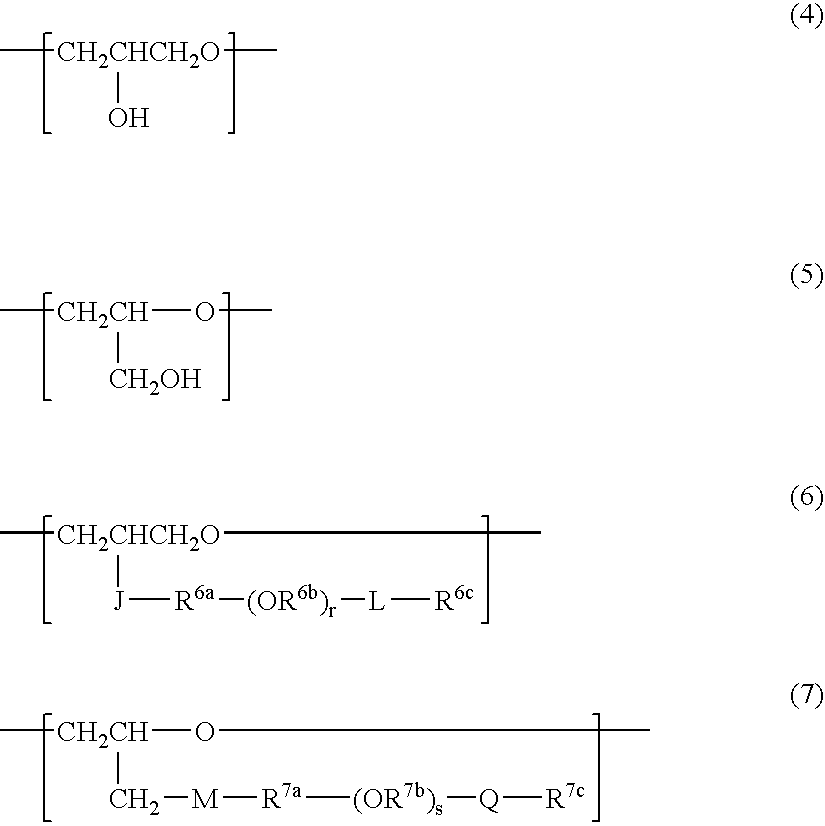Allergen Depressant And Depression Method
a technology which is applied in the field of allergen depressant and depression method, can solve the problems of increasing the number of allergens attributable to house dust, and achieve the effects of reducing allergens, improving operativeness, and reducing friction resistan
- Summary
- Abstract
- Description
- Claims
- Application Information
AI Technical Summary
Benefits of technology
Problems solved by technology
Method used
Image
Examples
example 1
[0143] Compounds A1 to M shown in Table 1 and Aculyn 22 were used to prepare sample solutions containing 0.01 wt % Compounds A1 to M and 15 wt % ethanol (special grade, SIGMA), the balance being water. These sample solutions were examined for the degree of residual activity of mite allergen R by the following QAS method. The results are shown in Table 1.
TABLE 1SampleDegree of residual activity of mite(%)Compound A1 solution35Compound A2 solution40Compound B solution50Compound C solution46Compound D solution50Compound E solution46Compound F solution32Compound G solution28Compound H solution32Compound I solution26Compound J solution28Compound K solution42Compound L solution48Compound M solution40Aculyn22(ISP Ltd.)36Ion exchange water10015% Aqueous ethanol (standard)100
wherein X is —OH, —Cl, —OCH3 or —OC2H4.
[0144] Compounds A1 to M were obtained by the following synthesis examples.
[0145] Aculyn22 is an acrylic acid / alkyl methacrylate / polyoxyethylene (average number of moles added:...
example 2
[0152] Space with a floor area of 7.4 m2 and a height of 2.3 m (capacity 17 m2, temperature 23° C.) was sealed, and a cotton futon actually used for 2 years in home was given with an impact for 10 seconds with a futon beater to generate dust in the space and stir up the dust. Then, 17 g of the allergen-reducing agent in Table 2 was sprayed into the space upward at a direction of 45° from a height of 1.7 meters over the floor by using a trigger-type spray (trigger attached to ALERUCLEAN Cleaning Spray for futon, manufactured by Kao Corporation).
[0153] Thirty minutes after spraying, a high-volume air sampler (HV-500F, Shibata Scientific Technology Ltd.) equipped with a glass fiber filter (GB-100R-110A, Shibata Scientific Technology Ltd.) was operated under the condition of 500 L / min. for 60 minutes on the floor, to capture dust on the filter. The glass fiber filter on which the dust had been captured was squeezed in 1 cc or less solution containing PBS (phosphate buffer solution, pH ...
example 3
[0156] Space with a floor area of 7.4 m2 and a height of 2.3 m (capacity 17 m2, temperature 23° C.) was sealed, and a cotton futon actually used for 2 years in home was given with an impact for 10 seconds with a futon beater to generate dust in the space and stir up the dust.
[0157] After 3 hours, the floor surface was cleaned at 20 seconds / m2 with a vacuum-cleaner (CV-CD4, suction power of 530 W, manufactured by Hitachi, Ltd.). Immediately thereafter, a sheet structure A wherein a nonwoven fabric obtained by a method of preparing a nonwoven fabric as shown below was impregnated at an impregnation degree of 250% (ratio by weight) with the allergen-reducing agent in Table 2 was fitted in Quickle Wiper (Kao Corporation) and used to wipe the floor surface.
[0158] After wiping, the floor surface was left for 3 hours and then wiped the whole floor surface with a wiping sheet B having a commercial cleaning sheet (Floor Quickle Dry Type, Kao Corporation) impregnated at an impregnation degr...
PUM
| Property | Measurement | Unit |
|---|---|---|
| frictional coefficient | aaaaa | aaaaa |
| mol % | aaaaa | aaaaa |
| mol % | aaaaa | aaaaa |
Abstract
Description
Claims
Application Information
 Login to View More
Login to View More - R&D
- Intellectual Property
- Life Sciences
- Materials
- Tech Scout
- Unparalleled Data Quality
- Higher Quality Content
- 60% Fewer Hallucinations
Browse by: Latest US Patents, China's latest patents, Technical Efficacy Thesaurus, Application Domain, Technology Topic, Popular Technical Reports.
© 2025 PatSnap. All rights reserved.Legal|Privacy policy|Modern Slavery Act Transparency Statement|Sitemap|About US| Contact US: help@patsnap.com



